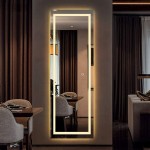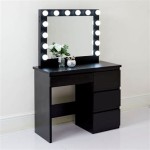How Do You Frame a Wall Mirror?
Framing a wall mirror elevates its aesthetic appeal and integrates it seamlessly into a room's decor. This process, while seemingly complex, can be achieved with the right tools, materials, and a methodical approach. This article will provide a comprehensive guide to framing a wall mirror, covering essential aspects from material selection to secure installation.
Choosing the Right Materials
The frame material significantly impacts the mirror's final look. Wood offers a classic, versatile option, available in various stains and finishes to complement different interior styles. Metal frames provide a sleek, modern aesthetic, while composite materials offer a cost-effective and lightweight alternative. Consider the existing decor, the mirror's size, and the desired overall aesthetic when selecting the frame material.
Accurate Measurement and Cutting
Precise measurements are crucial for a well-fitted frame. Measure the mirror's length and width accurately, factoring in any beveling or edging. Transfer these measurements to the chosen frame material, ensuring precise markings for cutting. Using appropriate cutting tools, such as a miter saw for angled cuts or a circular saw for straight cuts, is essential for clean, accurate edges. A properly calibrated measuring tape and a sharp pencil are indispensable for this stage.
Joining the Frame Pieces
Once the frame pieces are cut, they need to be joined securely. Wood frames can be joined using wood glue and reinforced with nails or screws. Metal frames typically require specialized joining techniques, such as welding or using metal brackets. Ensure the corners are aligned perfectly to create a seamless frame. Clamps can be invaluable for holding the pieces together while the adhesive sets.
Finishing the Frame
The finishing process enhances the frame's appearance and protects it from wear and tear. Wood frames can be stained, painted, or varnished to match the desired aesthetic. Metal frames might require a protective coating to prevent rust or corrosion. Allow ample drying time between coats for a smooth, even finish. Always ensure adequate ventilation when working with paints, stains, or sealants.
Attaching the Mirror to the Frame
Securing the mirror within the frame is a critical step. Mirror adhesive, specifically designed for this purpose, provides a strong and reliable bond. Apply the adhesive evenly to the back of the frame, ensuring full contact with the mirror's edges. Carefully position the mirror within the frame, applying gentle pressure to ensure proper adhesion. Allow the adhesive to cure completely before proceeding to the next step.
Adding Backing and Hanging Hardware
A backing board provides stability and protects the mirror's back. Cut a piece of sturdy material, such as plywood or hardboard, to fit the frame's back. Secure the backing board to the frame using adhesive or small nails. Install appropriate hanging hardware, such as D-rings or wire hangers, on the back of the frame. Ensure the hardware is securely attached and can support the combined weight of the mirror and frame.
Installing the Framed Mirror
Before hanging the mirror, carefully inspect the wall for any obstructions or electrical wiring. Mark the desired location on the wall, ensuring it is level. Use appropriate wall anchors and screws to securely hang the mirror, ensuring it is flush against the wall. Consider the surrounding décor and furniture placement for the optimal visual impact. Heavier mirrors may require additional support or specialized hanging hardware.
Considerations for Different Mirror Types
Different types of mirrors may require specific framing techniques. Large, heavy mirrors require robust framing materials and secure hanging methods. Beveled mirrors necessitate a deeper frame to accommodate the angled edges. Antique or delicate mirrors might require specialized handling and preservation techniques. Always consider the specific characteristics of the mirror when planning the framing process.
Safety Precautions
Working with glass and sharp tools requires appropriate safety precautions. Wear safety glasses to protect your eyes from flying debris. Use gloves to handle glass edges carefully, preventing cuts. Ensure adequate ventilation when working with adhesives, paints, or stains. Dispose of broken glass safely and responsibly. Following these safety guidelines will minimize the risk of accidents and ensure a successful framing project.

How To Frame A Mirror
:max_bytes(150000):strip_icc()/kaylasimonehome-905941da7dd04a08af07c415df2a1fd8.jpeg?strip=all)
20 Diy Mirror Frame Ideas To Inspire Your Next Project

How To Build A Diy Frame Hang Over Bathroom Mirror Love Our Real Life

20 Creative Diy Mirror Frame Ideas To Inspire Your Next Project Bathroom Mirrors Makeover

How To Frame A Mirror

How To Frame A Mirror

Diy Wood Mirror Frame For Bathroom Vanity Tidbits

How To Upgrade A Builder Grade Mirror Bob Vila

Mirror Silver Frame Chrome Frames Mirrormate

Thin Wood Rectangle Wall Mirror 24 W X 36 H West Elm








